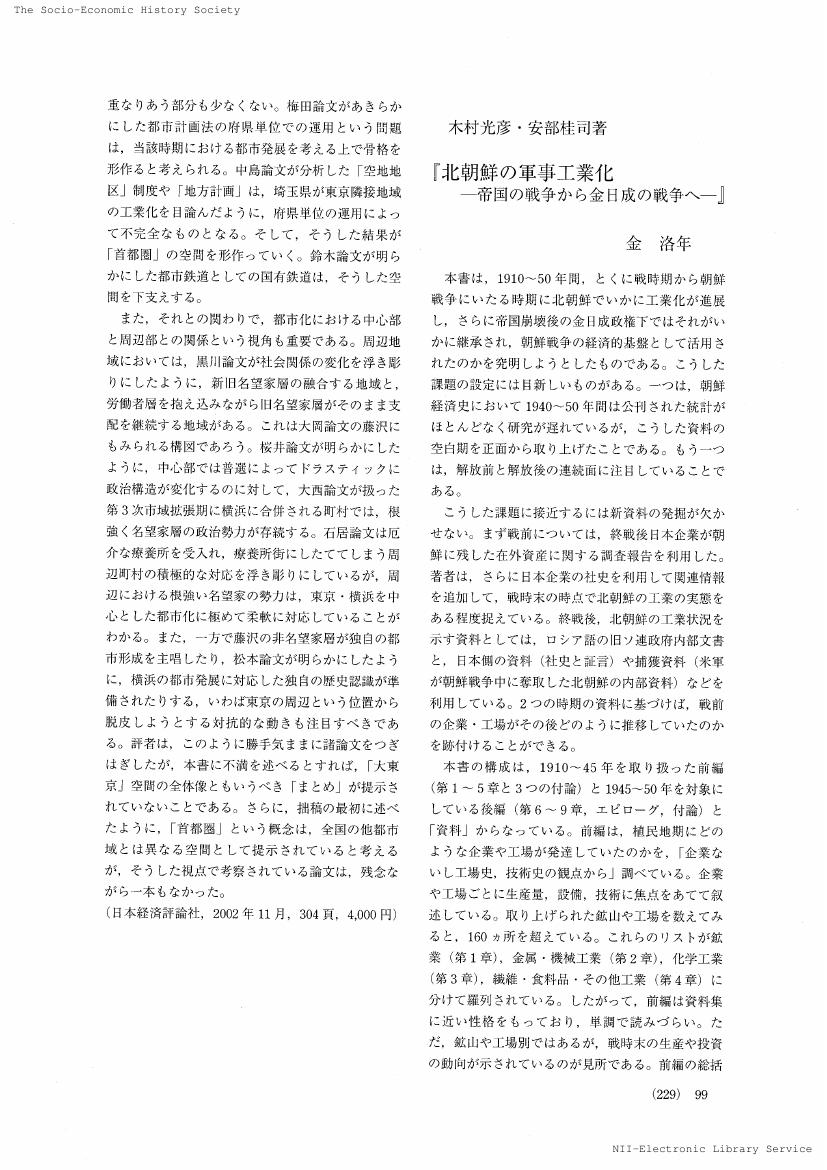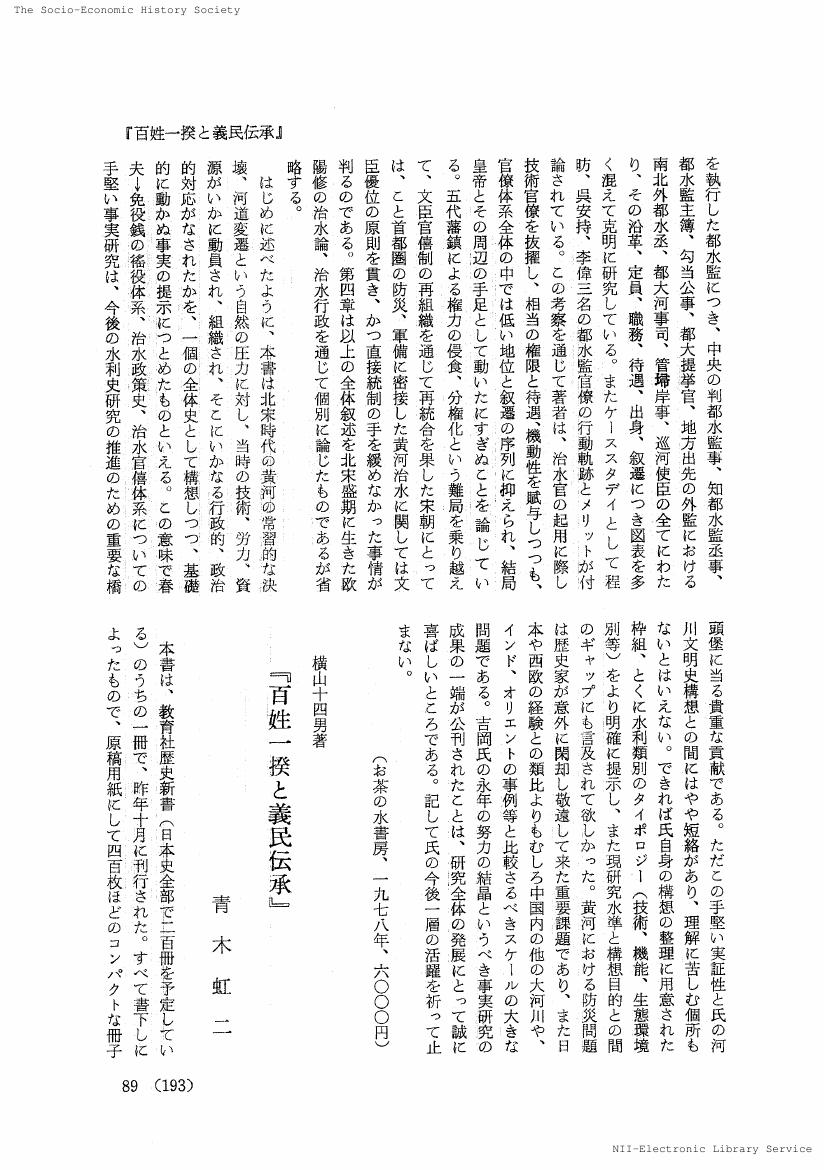67 0 0 0 OA 三菱端島における労働者の性格について : 敗戦から1960年代後半までの石炭産業
- 著者
- 宮地 英敏
- 出版者
- 社会経済史学会
- 雑誌
- 社会経済史学 (ISSN:00380113)
- 巻号頁・発行日
- vol.76, no.2, pp.203-224, 2010-08-25 (Released:2017-07-18)
本稿は,戦後の三菱端島の労働者を対象に,彼らの個票データを主たる史料として利用して,その出自・前歴・年齢などを分析することにより,炭鉱労働者の性格について考察した論文である。戦前以来の中四国から北部九州の炭鉱(特に坑内労働)へという労働移動は,戦後も引き続き数年間はみられたが,1950年代にはそれが南九州から北部九州へという労働移動に転じた。しかし石炭産業が構造不況業種となっていく中で,1950年代後半から末年にかけて農村からの労働力の吸引力は弱まり,中小炭鉱を含む他の炭鉱会社や関連業種などで働いた労働者たちの採用が増加していった。また,三菱端島での職種と前歴とのクロス分析では,農村出身者が低熟練の職種に就いたのに対して,他炭鉱などの経験者が相対的な熟練職種に就いていた。一方で工作見習や電工見習には,三菱端島労働者の子弟が大量に採用されるという傾向も抽出された。最後に,炭鉱労働者の「下降構造」というテーゼに対して,三菱端島のような大手炭鉱であっても,1960年代以降を中心に状況に応じて中小炭鉱経験者をも採用している点などを論じている。
46 0 0 0 OA 1879年コレラ流行時の有力船主による防疫活動 : 宮林彦九郎家の事例
- 著者
- 二谷 智子
- 出版者
- 社会経済史学会
- 雑誌
- 社会経済史学 (ISSN:00380113)
- 巻号頁・発行日
- vol.75, no.3, pp.313-336, 2009-09-25 (Released:2017-05-24)
近代史では,国民国家論の立場から幕末・明治期コレラ流行時の衛生が検討され,伝染病流行に直面した人々の生活の近代化過程が,民俗・心性・予防言説に焦点を絞って検討されてきたが,他方で,近世医療史の研究が進み,その歴史像に批判も出されている。本稿は,石川県(現富山県)の地域有力者であった宮林彦九郎家が,1879年コレラ流行時に交わした書簡を分析し,流行下でコレラに対応した人々の具体的な様相と,船主が実践した防疫の有り様を検討して,上述の争点に実証的な裏付けを提供する。船主兼地主の宮林家は,情報ルートを複数持ち,入手した情報を照らし合わせ,冷静かつ客観的に判断して,自己所有船と家族の防疫をした。地域では,地方行政官の意向も入れて地元の防疫活動を自発的に行った。この点には,近世以来の地域有力者による施療との同質性があり,地方行政官もそれを織り込んで,防疫活動を展開した。1879年コレラ流行を経験した宮林家は,地域住民の「智力ノ培養」が今後の重要課題となることを認識し,石川県地方衛生会の設置(1880年7月)より早い,80年1月に自費で新聞縦覧所を開設した。
46 0 0 0 OA 第二次世界大戦中の科学動員と学術研究会議の研究班
- 著者
- 青木 洋
- 出版者
- 社会経済史学会
- 雑誌
- 社会経済史学 (ISSN:00380113)
- 巻号頁・発行日
- vol.72, no.3, pp.331-353, 2006-09-25 (Released:2017-08-09)
- 参考文献数
- 55
- 被引用文献数
- 1
This article focuses on the activities of the Research Groups (Kenkyu han) promoted by the National Research Council of Japan (NRCJ) during World War II. Research collaboration has recently attracted the attention of many scholars as a factor in the development of Japanese technology. In fact, there were a large number of research collaboration activities during the period, and the Research Groups were one of the largest of such groups. NRCJ, established in 1920 under the supervision of the Ministry of Education, had been mainly involved in the promotion of international academic collaboration until World War II. But when the Board of Technology (Gijutsuin) was established for the mobilization of science and technology and the tide of the Pacific War turned against Japan, the Ministry of Education enforced a reform so that NCRJ could launch widespread research collaboration throughout the country. The Research Groups were organized in 1944, and at its peak had 193 groups and a total of over 1,900 scientists. Typical research issues included electronics, scarce and rare materials, and public health. These were similar to those of the Research Neighborhood Groups (Kenkyu tonarigumi), which were promoted by the Board of Technology, resulting in some duplication of activities between the two groups and leading to inefficiency in the mobilization of science and technology research.
23 0 0 0 十六世紀に於ける日本人奴隷問題 (上)
18 0 0 0 十六世紀に於ける日本人奴隷問題 (下)
15 0 0 0 OA シャハトのメフォ手形
- 著者
- 川瀬 泰史
- 出版者
- 社会経済史学会
- 雑誌
- 社会経済史学 (ISSN:00380113)
- 巻号頁・発行日
- vol.60, no.5, pp.655-682, 1995-01-25 (Released:2017-09-28)
Im August 1933 wurde Die Aktiengesellschaft, Metallurgische Forschungsgesellschaft m. b. H. gegrundet. Diese Firma war eine Scheinfirma der Reichsbank, die von Reichsbankprasidenten Hjalmar SCHACHT zur Rustungsfinanzierung geschaffen wurde. Man hat diese Firma abgekurzt Mefo genannt. Zuerst hat die Rustungsindustrie Mefo-Wechsel ausgestellt und diese Wechsel an die Mefo gesandt, die diese akzeptierte. Danach hat die Mefo diese Wechsel der Rustungsindustrie zuruckgegeben. So wurde Mefo-Wechsel entstanden. Von 1934 bis 1938 wurden Mefo-Wechsel im Wert von 12 Milliarden RM ausgestellt. SCHACHT befurchtete, din Zunahme von Mefo-Wechseln konne zu Inflation fuhren. Deswegen wurde auf seine Veranlassung von Mefo-Wechseln am 31. Marz 1938 eingestellt. Ab Fruhling 1939 sollte das Reich die Mefo-Wechsel einlosen. SCHACHT und das Reichsbankdirektorium sandten ein Momorandum an Adolf HITLER, in dem sie fordernten, daβ die Reichsbank den Kapitalmarkt kontrollieren solle. Das bedeutete, daβ die Reichsbank nicht langer die Rustungsfinanzierung unterstutzte. Deshalb muβte SCHACHT als Reichbankprasident zurucktreten. Das System der Mefo-Wechsel bedeutete Rustungsfinanzierung durch Kredite. SCHACHT befurwortete eine mit Sparsamkeit verbundene Konsolidierungspolitik, aber NS-Staat konnte oder wollte SCHACHTS Vorschlagen nicht folgen.
11 0 0 0 OA 幕末維新期の商品流通と貨幣の使用実態について : 東讃岐地方の事例から
- 著者
- 加藤 慶一郎 鎮目 雅人
- 出版者
- 社会経済史学会
- 雑誌
- 社会経済史学 (ISSN:00380113)
- 巻号頁・発行日
- vol.79, no.4, pp.545-561, 2014-02-25 (Released:2017-05-17)
本稿では,幕末維新期における貨幣の使用実態について検討する。具体的には,幕末において主に匁建ての藩札が使用されていた東讃岐地方の商家の帳簿に記載された個々の取引の分析をもとに,同地方において匁建ての藩札から円貨による取引に移行する過程を明らかにする。分析の結果,新貨条例が公布され,円という通貨単位が導入された明治4年時点では,東讃岐地方では主に匁建ての藩札が使用されていたと考えられること,明治4年から明治9年頃までの間,東讃岐地方では,円単位の紙幣のほか,匁単位の藩札,銭貨などの各種貨幣が混合流通していた可能性が高いこと,明治9年の秋口以降,支払いにおける円貨の比率が急速に高まり,地域内における貨幣の流通状況に変化が生じていたことが示される。本稿の方法論を,各地に残された帳簿の分析に応用することで,同時期における貨幣使用の実態を,より厳密なかたちで検証することができると考えられる。
11 0 0 0 OA 戦前期台湾・関東州製塩業における日系資本の進出過程 : 野崎家と大日本塩業株式会社を中心に
- 著者
- 前田 廉孝
- 出版者
- 社会経済史学会
- 雑誌
- 社会経済史学 (ISSN:00380113)
- 巻号頁・発行日
- vol.78, no.3, pp.335-360, 2012-11-25 (Released:2017-06-15)
本稿の課題は,第1次大戦期までにおける日系製塩資本の台湾と関東州への進出過程を検討し,それら勢力圏下製塩業が内地への原料供給地としての役割を果たすに至った過程を明らかにすることである。これを受けて本稿では,野崎武吉郎家と大日本塩業株式会社を事例に,(財)竜王会館所蔵野崎家文書と日塩(株)所蔵史料を主に用いて考察を進めた。本稿の考察より,第1次大戦期まで食塩供給地としての政策的位置づけを得ていなかった勢力圏下製塩業への日系資本の進出とその後の事業は,塩専売制度導入を画期とする内地食塩市場の構造的変化に呼応して展開されたことが明らかになった。さらに,第1次大戦期における内地の食塩需要の急激な拡大に起因した塩専売政策の転換により,台湾・関東州製塩業は内地への原料供給地として勢力圏下の分業構造に組み込まれたのであった。一方で,第1次大戦後には原料塩獲得を目的とした勢力圏下製塩業への食塩需要者による直接進出が活発化した。このことから,国家にとっての原料資源の重要性が増大した第1次大戦期を画期として,日系製塩資本の進出動機は大きく変化した可能性が示唆された。
11 0 0 0 OA 見市雅俊著, 『コレラの世界史』, 晶文社、一九九四年四月、二八四+xv頁、三九〇〇円
- 著者
- 川北 稔
- 出版者
- 社会経済史学会
- 雑誌
- 社会経済史学 (ISSN:00380113)
- 巻号頁・発行日
- vol.61, no.4, pp.556-559, 1995-11-25 (Released:2017-06-24)
- 著者
- 永岑 三千輝
- 出版者
- 社会経済史学会
- 雑誌
- 社会経済史学 (ISSN:00380113)
- 巻号頁・発行日
- vol.78, no.1, pp.157-159, 2012
9 0 0 0 日本近代の民衆経験に見る<祝祭商品>の同時代的意義の再考
- 著者
- 右田 裕規
- 出版者
- 社会経済史学会
- 雑誌
- 社会経済史学 (ISSN:00380113)
- 巻号頁・発行日
- vol.79, no.1, pp.101-116, 2013
近代日本社会に現前した祝祭商品の氾濫という事態はどのような歴史社会的意義を含んだ現象だったと考えられるか。とりわけその消費者であった同時代の人びとの集合的経験・意味づけに即したとき,それはどのような社会的要素から生まれ,またどのような社会的作用を及ぼした現象であったと解釈できるか。本稿では,この問いについて昭和大礼を具体的事例にとりあげつつ再検討することが目指される。本稿の指摘は主に次の3点にまとめられる。第1に,祝祭商品への社会的需要は多くの場合,人びとの愛国的な動機(祝祭参加,奉祝への欲望)からではなく,消費をめぐる世俗で私的な欲望から生成されていたこと。第2に,祝祭商品に付された天皇家の表象は多くの場合,消費への耽溺を正統づける記号として社会的に解釈され作用していたこと。第3に,同時代の多くの人びとにとって祝祭商品の氾濫は消費をめぐる私的な欲望が一時的に正統づけられ解放される契機として体験されていたこと。この3点を指摘することで,従来のナショナリズム論的な解釈とは異なる,祝祭商品の史的意義についての文化論的な解釈が提起される。
9 0 0 0 第二次世界大戦中の科学動員と学術研究会議の研究班
- 著者
- 青木 洋
- 出版者
- 社会経済史学会
- 雑誌
- 社会経済史学 (ISSN:00380113)
- 巻号頁・発行日
- vol.72, no.3, pp.331-353, 2006
- 参考文献数
- 55
- 被引用文献数
- 4
This article focuses on the activities of the Research Groups (Kenkyu han) promoted by the National Research Council of Japan (NRCJ) during World War II. Research collaboration has recently attracted the attention of many scholars as a factor in the development of Japanese technology. In fact, there were a large number of research collaboration activities during the period, and the Research Groups were one of the largest of such groups. NRCJ, established in 1920 under the supervision of the Ministry of Education, had been mainly involved in the promotion of international academic collaboration until World War II. But when the Board of Technology (Gijutsuin) was established for the mobilization of science and technology and the tide of the Pacific War turned against Japan, the Ministry of Education enforced a reform so that NCRJ could launch widespread research collaboration throughout the country. The Research Groups were organized in 1944, and at its peak had 193 groups and a total of over 1,900 scientists. Typical research issues included electronics, scarce and rare materials, and public health. These were similar to those of the Research Neighborhood Groups (Kenkyu tonarigumi), which were promoted by the Board of Technology, resulting in some duplication of activities between the two groups and leading to inefficiency in the mobilization of science and technology research.
- 著者
- 金 洛年
- 出版者
- 社会経済史学会
- 雑誌
- 社会経済史学 (ISSN:00380113)
- 巻号頁・発行日
- vol.70, no.2, pp.229-231, 2004-07-25 (Released:2017-08-09)
7 0 0 0 OA 18世紀イギリスの陸軍兵士とその家族
- 著者
- 辻本 諭
- 出版者
- 社会経済史学会
- 雑誌
- 社会経済史学 (ISSN:00380113)
- 巻号頁・発行日
- vol.80, no.4, pp.567-588, 2015 (Released:2017-03-15)
7 0 0 0 OA 昭和初期における被服協会の活動 : カーキ色被服普及の試みと挫折
- 著者
- 井内 智子
- 出版者
- 社会経済史学会
- 雑誌
- 社会経済史学 (ISSN:00380113)
- 巻号頁・発行日
- vol.76, no.1, pp.99-118, 2010-05-25 (Released:2017-07-18)
- 被引用文献数
- 1
1929年に設立された陸軍被服協会は,被服資源を確保して総力戦体制へ備えるため,国産毛織物の普及及び軍用被服と民間被服の規格統一を目指して活動した。同協会は,具体的には洋装化の推進を呼びかけ,学生服をはじめとする各種制服を統一して,軍服と同じカーキ色の毛織物にする「被服統一運動」を行い,軍需被服産業と毛織物産業を中心とする諸企業の支持を得た。第一次大戦後の軍縮の中で,軍需関係の企業は軍需から民需への転換を図っていた。また,毛織物の集散地だった大阪の財界を中心に,軍需以外の諸企業も不況の中で消費が減少することを防ぐ目的で被服協会を支援した。今回本稿がとりあげる1929年から1934年にかけては,一般の反軍感情が強く,陸軍の望むカーキ色生地普及はこの色が軍隊のイメージと強く結びついていたため挫折する。また,毛織物の制服では綿に比べて高価になることから,毛織物普及にも限界があった。しかし,被服協会は府県単位での男子中等学校制服の統一を進め,統一したことで制服の価格は下がっていった。
- 著者
- 藤井 信幸
- 出版者
- 社会経済史学会
- 雑誌
- 社会経済史学 (ISSN:00380113)
- 巻号頁・発行日
- vol.74, no.6, pp.621-623, 2009-03-25 (Released:2017-07-22)
6 0 0 0 OA 戦前期日本の鉄道業における木材利用 : 国有鉄道の枕木調達を中心に
- 著者
- 山口 明日香
- 出版者
- 社会経済史学会
- 雑誌
- 社会経済史学 (ISSN:00380113)
- 巻号頁・発行日
- vol.76, no.4, pp.547-570, 2011-02-25 (Released:2017-07-18)
本稿の目的は,産業化における木材利用の視点から,とくに産業資材としての木材に注目し,国有鉄道による枕木の調達・利用方法を明らかにすることである。近代日本の産業化の過程において木材は,エネルギー,資材,原料として利用され,木材の需要構造の変化や供給不足などに対応して,長期的な木材所要量の確保は各産業にとって克服すべき課題となった。1870年代以降,鉄道網の拡張に伴い枕木需要は拡大し,国有鉄道は1909年度分の枕木購入に際し「一般競争入札」から「随意契約」に調達方法を変更した。さらに国有鉄道は,1930年度に予算不足により枕木買入単価を引き下げて所要量を確保するため,調達方法を「指名競争入札」に変更したが,1933年度には「益金」が増加して予算不足が解決され,また木材市場が回復したために再び「随意契約」に戻した。こうした調達方法の変更を通じて国有鉄道は木材市場や予算の変化に柔軟に対応したが,単年度主義の予算制約から長期的な枕木確保の対応策をとれなかった。国有鉄道は,使用樹種の拡大や防腐枕木の利用により枕木不足を解消しようとしたが,とくに1930年代後半以降,枕木不足は深刻化した。
6 0 0 0 OA 横山十四男著, 『百姓一揆と義民伝承』, 教育者、一九七七年、六〇〇円
- 著者
- 青木 虹二
- 出版者
- 社会経済史学会
- 雑誌
- 社会経済史学 (ISSN:00380113)
- 巻号頁・発行日
- vol.44, no.2, pp.193-196, 1978-07-25 (Released:2017-11-24)
- 著者
- 上山 和雄
- 出版者
- 社会経済史学会
- 雑誌
- 社会経済史学 (ISSN:00380113)
- 巻号頁・発行日
- vol.72, no.3, pp.361-363, 2006-09-25 (Released:2017-08-09)
6 0 0 0 OA 江戸時代貨幣表の再検討
- 著者
- 田谷 博吉
- 出版者
- 社会経済史学会
- 雑誌
- 社会経済史学 (ISSN:00380113)
- 巻号頁・発行日
- vol.39, no.3, pp.261-279, 1973-10-25 (Released:2017-07-22)
During the Edo period, the leading currencies were gold, silver, and copper coins issued by the Tokugawa Shogunate. Though various kinds of paper money were issued by territorial lords (Daimyo) especially in the latter half of the Edo period, it was necessary to obtain the permit of the Shogunate to issue money. In commercial transactions, the most important currencies were gold and silver coins of the Shogunate, which were produced in more than 40 different kinds. In order to study the monetary transactions of the period, it is therefore necessary to classify these various sorts of coins by the time of issue (Keicho, Genroku-Hoei, Shotoku-Kyohou, Genbun, Bunsei, Tenpo, Ansei-Manyen) and show the date of issue, the years of circulation, the weight and fineness, the amount of issue, etc. There are two kinds of currency table showing the above items : one made by Chuzaburo Sato, an official of the mint of gold coins of the Shogunate, in 1873; and the other by the Osaka Mint of the Meiji government in 1921.Though the one made by Chuzaburo Sato is more useful to the study of Tokugawa currency, his table is based on the materials in the last part of the Edo period. The present writer constructs a new table using earlie source materials in this paper.





